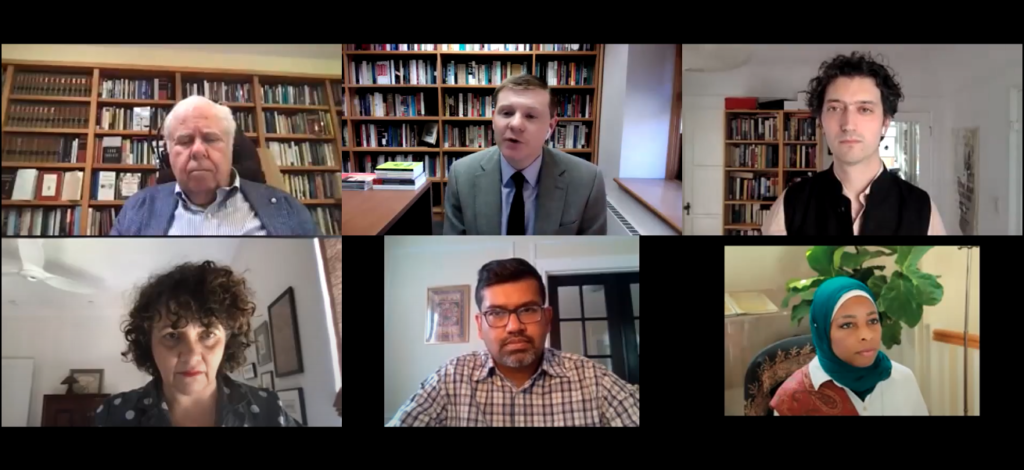Tanner Allread’s article summarizes the proceedings of “Originalism Across Legal Traditions: An Interdisciplinary Conversation,” presented by the University of Southern California’s USC-Huntington Early Modern Studies Institute, in collaboration with USC’s Center for Law, History and Culture, on May 26, 2021, featuring Sanford Levinson, Jonathan Gienapp, Nathan Perl-Rosenthal, Dierdre Lynch, Rohit De, and Intisar Rabb.
Constitutional originalism has become a dominant theory in American law. Law schools are home to leading originalist scholars, and scholarship written on the original meaning of numerous constitutional provisions fill the pages of law reviews. Beyond academia, originalism has risen to a place of prominence in the United States judiciary, most visibly in the composition of the Supreme Court. Still, despite its strength, discussions on the underlying tenets of originalism—that a field should consider a text foundational, and that the meaning of that text was fixed at the time of its creation—have remained singularly focused on the United States legal tradition.
Seeking to overcome these constraints, the University of Southern California’s USC-Huntington Early Modern Studies Institute, in collaboration with USC’s Center for Law, History and Culture, convened a virtual panel of scholars on May 26, 2021 to discuss how different traditions approach their fundamental texts. The event, entitled “Originalism Across Legal Traditions: An Interdisciplinary Conversation,” sought to explicitly move beyond American constitutional originalism to look at foundationalist approaches broadly, comparatively, and globally. Moderated by Jonathan Gienapp and Nathan Perl-Rosenthal, the panel featured Sanford Levinson, Rohit De, Intisar Rabb, and Deidre Lynch, a cohort of historians and legal scholars whose expertise covers multiple fields and regions of the globe. Over the course of two hours, this diverse group of scholars set out to identify the legal and non-legal foundational texts in their fields, explain how these texts became definitive, and describe the mechanisms through which the interpretation of these texts is regulated.

Coming to this discussion from disparate traditions, the panel first introduced the foundational texts of their respective fields. In the context of Islamic law, Intisar Rabb explained that jurisprudence proceeds on an assumption of static, original meaning rooted in a set of fundamental texts, even though the dynamic interpretation of these texts reveals ever-changing meanings. Rabb identified the Quran, the Sunnah—the body of traditional social and legal custom and practices of Islam—and the Hadith—posthumously recorded sayings of the Prophet Muhammad—as the textual sources of Islamic, or Sharia, law. Despite these common texts, she also emphasized that tools of interpretation, such as Sunni and Shia approaches to legal reasoning and anonymized, widely used legal canons, are extratextual, established components of the Islamic legal tradition.
Moving from the religious to the secular, Rohit De identified the Constitution of India as the supreme law of its legal system. The Indian Constitution, which became effective in 1950, was neither an indigenous form of governance nor a popular constitution. Rather, as De explained, the Constitution continued forms of colonial law and was drafted by the Constituent Assembly, a body composed of mostly Hindu elites and a small but vocal group of minorities. Still, De described the document as “exceptional” because of its status as a postcolonial constitution that has endured for seventy years. Key to its continued survival, the Indian Constitution has proven to be flexible: amendment is easy, some clauses were only meant to be temporary, and constitutional change has been influenced by judicial reasoning and political and social movements. And even though the constitution is a foundational text, De stated that Indian jurisprudence has rejected interpretations based on fixity. According to him, transformative ideas, as expressed in social movements, and the act of assembling around an idea, rather than the act of founding, determine constitutional meaning in India.
Returning the focus to the United States, Sanford Levinson specifically focused on the pedagogical canon of law.[1] Rather than the Constitution, Levinson pointed to decided cases by the federal judiciary as the foundational texts for teaching law students. He described how law professors teach students to “milk” these cases in order to achieve the desired outcomes for their clients. Although Levinson dismissed the Constitution as a foundation for law pedagogy, he still identified the document as the fundamental text for learning how to be a citizen who could engage with both the “Settlement Constitution”—the textual provisions with clear, pragmatic meaning—and the “Constitution of Conversation”—ambiguous clauses requiring discussion and critical thinking to determine their meaning.
Turning away from textual content, Deidre Lynch complicated the notion of a foundational text by emphasizing the importance of form in determining what is foundational. Lynch identified a category of books of a particular bibliographic format, namely the collected standard works of an author, as an example of how form can result in the construction of “sovereign texts.” An invention of the late eighteenth century, these collected editions existed as tangible proof of an author’s status. According to Lynch, compiling an author’s works bestowed lasting fame upon the author and notions of textual integrity and completeness upon their writings, sealing the works off from differing interpretations. However, she invoked the experience of book historians to caution students of constitutional law about the illusory promise of the idea of fixity. Despite the finality that seems to attach to “complete” editions, individuals have long modified bound sets of writings by cutting the bindings and adding in new texts and illustrations, physically tinkering with the composition of a supposedly fixed object.
After describing the foundational texts of their respective fields, the participants discussed the moments at which the meanings of these documents became definitive. Interestingly, no panelist stated that their text had actually achieved closure. Rabb argued that the process of interpreting Islamic law is ongoing and dialectic. Following Nathan Perl-Rosenthal’s reference to her book Doubt in Islamic Law: A History of Legal Maxims, Interpretations, and Islamic Criminal Law, Rabb explained how Islamic jurists’ concerns with prescribing criminal punishment in cases of doubt have led them to avoid the demands of harsh punishment found in Islamic texts.[2] Similarly, Lynch contended that even though collected editions privilege a complete, author-centered interpretation, readers make literature more than authors. Thus, although publishers sell closure with these compilations, readers actually become interested in the author’s writings that are not included in them.
Beyond the ongoing processes that work against definitive understandings, panelists also highlighted certain local factors that influence interpretation. Levinson focused on the importance of language in the context of the U.S. Constitution, noting how it had to be translated into German and Dutch at the Founding due to the large numbers of German and Dutch speakers who lived in states like Pennsylvania and New York. He pointed out that the constitutional language differed from the original when it was translated back into English, undermining the notion of a common understanding of its meaning. Relatedly, De described how the fact that the Indian Constitution was written in English made some concepts untranslatable in languages used in the country. Furthermore, the length of the Constitution made its dissemination to the public difficult, hindering widespread knowledge of its content. With many groups knowing no more than a few provisions based on geography or their profession, De explained that increasing coverage of the document in newspapers, by civil society groups, and on the Internet have only recently brought more attention to the Constitution as a whole.
The panel also connected this lack of closure to the obstacles that legal regimes face in policing and negotiating interpretations of foundational texts. Rabb contended that the interpretation of Islamic law is heavily dependent on time and place. Political communities across Asia, the Middle East, and Africa use Islamic law, and millions of other Muslims outside these communities follow it. Rabb stated that Islam’s status as an identarian community allows for multiple points of policing by state and non-state actors, including U.S. courts which will enforce Muslim marriage contracts as prenuptial agreements. And in the Indian context, De explained that negotiation looks very different when compared to the U.S. legal tradition. The government is conceived of as a vehicle for social and economic change, not the protection of individual liberties. Moreover, De described how constitutional interpretation is facilitated through oral traditions, rather than textual methods, in many communities in India.
Although the conversation had mostly focused on the diversity across these traditions, the panelists’ final points revealed common ground on the hegemonic effects of foundationalism. In response to an audience question on the rise of originalism, Lynch and Rabb agreed that the turn to fixed meanings of foundational texts in both English literature and Islamic law arose as a response to change and pluralism, seeking to preserve the status quo. De also argued that originalist approaches erase what came before the creation of foundational texts, such as the way the Indian Constitution overshadowed the importance of Queen Victoria’s Proclamation of 1858, known as the “Indian Magna Carta.”
In outlining these common tenets of foundationalism, the conclusion of the event suggested that a comparative and global approach to originalism can yield important insights into its rise and features within various legal traditions while complicating the novelty of American constitutional originalism. Even though two hours was a short time to elucidate a generalized concept useful for future scholarship, the event will hopefully inspire historians and legal scholars to continue having these conversations and fundamentally rethink the histories of foundational texts.
[1] For further discussion of Levinson’s pedagogical canon of law, see J.M. Balkin and Sanford Levinson, “The Canons of Constitutional Law,” Harvard Law Review 111 (1998): 963-1022.
[2] Intisar Rabb, Doubt in Islamic Law: A History of Legal Maxims, Interpretations, and Islamic Criminal Law (New York: Cambridge University Press, 2015).


